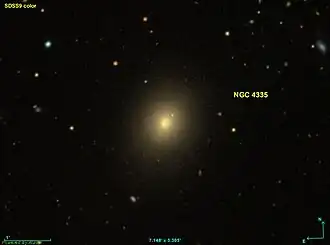NGC 4335
| NGC 4335 | |
|---|---|
 NGC 4335 imaged by SDSS | |
| Observation data (J2000 epoch) | |
| Constellation | Ursa Major |
| Right ascension | 12h 23m 01.8985s[1] |
| Declination | +58° 26′ 40.432″[1] |
| Redshift | 0.015371±0.00000418[1] |
| Heliocentric radial velocity | 4,608±1 km/s[1] |
| Distance | 228.7 ± 16.0 Mly (70.11 ± 4.91 Mpc)[1] |
| Apparent magnitude (V) | 13.40[1] |
| Characteristics | |
| Type | E[1] |
| Size | ~134,200 ly (41.15 kpc) (estimated)[1] |
| Apparent size (V) | 1.9′ × 1.5′[1] |
| Other designations | |
| IRAS F12206+5843, UGC 7455, MCG +10-18-035, PGC 40169, CGCG 293-015[1] | |
NGC 4335 is an elliptical galaxy in the constellation of Ursa Major. It was discovered by German-British astronomer William Herschel on 17 April 1789.[2] Its velocity with respect to the cosmic microwave background is 4,753±10 km/s, which corresponds to a Hubble distance of 228.7 ± 16.0 Mly (70.11 ± 4.91 Mpc).[1]
NGC 4335 is a radio galaxy, i.e. it has giant regions of radio emission extending well beyond its visible structure.[3]
According to Abraham Mahtessian, NGC 4335 and NGC 4362 form a pair of galaxies.[4]
Supermassive black hole
According to a study published in 2009, and based on the internal velocity of the galaxy measured by the Hubble Space Telescope, the mass of the supermassive black hole at the center of NGC 4335 is between 130 and 550 million M☉.[5]
Supernova
One supernova has been observed in NGC 4335:
- SN 1955E (type unknown, mag. 16.3) was discovered by Fritz Zwicky on photographic plates dated 10 May 1955, but they were not found until early 1968.[6][7]
Image gallery
-
 NGC 4335 imaged by the Hubble Space Telescope
NGC 4335 imaged by the Hubble Space Telescope
See also
References
- ^ a b c d e f g h i j k "Results for object NGC 4335". NASA/IPAC Extragalactic Database. NASA and Caltech. Retrieved 12 August 2025.
- ^ Seligman, Courtney. "New General Catalogue Objects: NGC 4335". Celestial Atlas. Retrieved 12 August 2025.
- ^ "NGC 4335". SIMBAD. Centre de données astronomiques de Strasbourg. Retrieved 12 August 2025.
- ^ Mahtessian, A. P. (1998). "Groups of galaxies. III. Some empirical characteristics". Astrophysics. 41 (3): 308–321. Bibcode:1998Ap.....41..308M. doi:10.1007/BF03036100.
- ^ Beifiori, A.; Sarzi, M.; Corsini, E. M.; Bontà, E. Dalla; Pizzella, A.; Coccato, L.; Bertola, F. (2009). "UPPER LIMITS ON THE MASSES OF 105 SUPERMASSIVE BLACK HOLES FROM HUBBLE SPACE TELESCOPE /SPACE TELESCOPE IMAGING SPECTROGRAPH ARCHIVAL DATA". The Astrophysical Journal. 692 (1): 856–868. arXiv:0809.5103. Bibcode:2009ApJ...692..856B. doi:10.1088/0004-637X/692/1/856.
- ^ Zwicky, F. (15 March 1968). "Supernovae". International Astronomical Union Circular (2058): 1.
- ^ "SN 1955E". Transient Name Server. IAU. Retrieved 12 August 2025.
External links
 Media related to NGC 4335 at Wikimedia Commons
Media related to NGC 4335 at Wikimedia Commons- NGC 4335 on WikiSky: DSS2, SDSS, GALEX, IRAS, Hydrogen α, X-Ray, Astrophoto, Sky Map, Articles and images